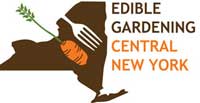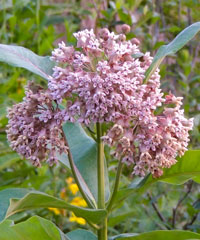Our Vanishing Night: Light Pollution
|
 | | The eastern seaboard at night |
| |
|
A World of Health: Connecting People, Place, and Planet
|  | |
Living Green, Living Good in CNY (www.lglgcny.org) is sponsoring the Northwest Earth Institute's discussion course A World of Health: Connecting People, Place, and Planet.
The course discusses limitations of the current medical model and its approach to health, then addresses the places where our personal health intersects with the environment - from our food and homes, to our communities and society. Throughout the course you will find individual actions that promote good health and in turn, promote a healthier environment.
Here's more information about this course.
We'll meet once a week for six weeks. The dates for the course are the six Fridays from April 5 to May 10 at 7:00 pm at our home in Westvale.
OCPL has purchased a set of course books that can be checked out, so participation is free for the first 8 people who register.
If you're interested
in learning more about participating, contact Janet Allen.
|
Chasing Ice
"One of the most beautiful films of the year"
Mon., April 22 at 7:00 pm at The Palace Theater
|  |
This film has won 23 awards at film festivals around the world. Following the film, a Climate Impacts and Actions in CNY panel presentation will explore the documentary's environmental implications from a local perspective. The panel will consist of Dave Eichorn, syracuse.com meteorologist; Chris Carrick, Energy Program Manager for the Central New York Regional Planning and Development Board; and Yvonne Rothenberg, Founder of the CNY chapter of the Citizens Climate Lobby. Moderating the panel will be Chris Bolt, WAER news and public affairs director. Suggested donations: At the door: $10 Seniors/students: $5 Children 12 and under: Free For advance sale tickets, go to Greening USA. Free parking in rear of Palace Theater. |
| Our Habitat Garden |  |
Visit Our Habitat Garden website for information on providing habitat, earth-friendly gardening practices, plants, and various creatures here in Central New York.
|
HGCNY Officers
| |
| President:
Janet Allen
Vice-President:
Carol Biesemeyer
Treasurer:
Randi Starmer
Secretary:
Soule Leiter
Membership:
Linda Rossiter
Program Chair:
Carol Biesemeyer
Newsletter Editor:
Janet Allen
Additional Planning Committee Members:
Beth Mitchell
Dave Mitchell
John Allen
Peter Huntington
|
| HGCNY on Facebook |
As as more of us participate on our Facebook page, this will become a useful resource for asking (and answering!) local HGCNYers' questions about habitat gardening. |
|
Join HGCNY!
|  |
Becoming an official member of HGCNY is easy: just join Wild Ones! Basic household membership is $37/year, but there are other options, too. (See membership application or website.)
Wild Ones
P.O. Box 1274
Appleton, Wisconsin 54912-1274
Make checks payable to Wild Ones.
Or telephone toll-free 877-394-9453.
|
|
Our Edible Garden
|  | Visit OurEdibleGarden.org to see an example of a Central New York edible garden, the perfect companion to your habitat garden.
|
| Interested in Edible Gardening? | 
|
If you'd like to get information on Edible Gardening CNY, just email John to find out about edible gardening tours and monthly programs. Free and open to the public! |
|
Greetings!
 | Serviceberry cultivar --
with few berries! |
Dan Segal of The Plantsmen Nursery in Ithaca - and a national Wild Ones Board member - will present "Cultivars of Native Plants: Thanks But No Thanks." Cultivars have overtaken mainstream horticulture because they are the currency of mass production and mass marketing. Now the cultivar epidemic threatens native plants too. Find out how and why this is happening, and how cultivars undermine the fundamental principles of ecology without which native plants are just pretty faces lacking substance. When:
Sunday, March 24 at 2:00 pm
(Because of Easter, NOT our usual "last Sunday of the month" date.) Where: Liverpool Library ( Directions) Free and open to the publicLooking ahead
Our final regular program this year will be: Sun. April 28: Jim D'Angelo will return to talk about another creature in our habitat gardens. Monarch programsI'll be giving presentations about Creating a Monarch and Butterfly-friendly yard at the following times and locations:
Wed. March 20 at 7:30 pm Sierra Club Meeting at University United Methodist Church 1085 E. Genesee St. Syracuse
Free and open to the public Tues. April 23 at 6:30 pm Fulton Public Library Sat. May 4 at 10 am at Baltimore Woods Nature Center Sat. May 4 at 3 pm at Beaver Lake Nature Center Wed. May 8 at 6:30 pm Liverpool Public Library Thurs. June 13 at 7:00 pm Dewitt Community Library Janet Allen President, HGCNY |
|
|
How does a conspicuous bright red bird thrive?

We'll all learned of the value of camouflage for animals' survival. So why does a bright red bird like the cardinal thrive, especially with its low rate of nesting success?
Cornell's Lab of Ornithology -- with the help of the data collected by citizen scientists -- has some answers.
* Since they don't migrate, they have a long breeding season, starting early in the spring and lasting into the fall.
* They're habitat generalists, able to nest in places as varied as woodlands and deserts -- and including our yards. And they aren't particular as to specific nesting sites. Researchers found nests in locations that weren't very different than ones researchers chose at random.
* Even though this bright red bird singing from the highest perches would seem to make good hawk chow, it also makes him very attractive to female cardinals. The brightest birds have high reproductive success and hold better territories.
And their redness is related to what they've been eating, so females select really red mates since they're likely to be healthy. BUT, interestingly for us habitat gardeners, this relationship may not hold as strongly for birds in urban settings because of novel food sources.
Learn more about cardinals from Cornell's Lab of Ornithology "Why so red, Mr. Cardinal?"
Participate in NestWatch this year
Scientists need lots of data to learn more about birds' nesting habits. YOU can be a citizen science NestWatcher! They need information about many common birds such as chickadees, house wrens, cardinals, so it's likely to be something you could do right in your own yard.
Learn how you can participate in Cornell's NestWatch this year.
|
|
Returning monarch population ominously low
 | | Will our grandchildren have monarchs to enjoy? |
This year's figures show that the monarch population is at its lowest level since records have been kept. The population is only 1/15 of the size it was in 1997!
Experts agree that this is now a continuing trend, not a series of random events. Here are some of the reasons they offer for the decline:
* Illegal logging in Mexico: Some say this is no longer an issue, but some say there is still a problem in parts of the overwintering sites.
* Climate change and drought
* Lack of milkweeds, partly due to agricultural pesticides that kill milkweeds
As Lincoln Brower, one of the world's foremost experts on monarchs and the migration, said, "[T]he report of the dwindling Monarch butterfly winter residence in Mexico is ominous."
Read more on the New York Times article.
Learn more about the migration news on Journey North. |
|
Monarch action in the Adirondacks
 | | Common milkweed (Asclepias syriaca) |
Many CNYers vacation in the Adirondacks or may even have a camp there, so you're probably familiar with monarchs in that region.
You're probably also familiar with roadside mowing in August that destroys milkweed before the monarchs could "hatch" (or more correctly, "eclose"). This generation that is being destroyed is the generation that migrates to Mexico and creates the following year's new monarchs!
A non-profit called AdkAction.org has ambitious plans to help monarchs. First, they have already written to every highway department in the Adirondack Park asking them to delay mowing. Over the winter, this has started a regional initiative on monarch and milkweed conservation. Now, they're planning to distribute 10,000 copies of a monarch brochure throughout the 6-million-acre park. Each brochure will contain a zip-lock bag with common milkweed seeds attached. They're working with their partner, The Wild Center, the Natural History Museum of the Adirondacks. They're also working with gardening groups, written letters to the editor, continuing contact with highway department supervisors, and working with plant nurseries to supply nectar plants. Besides urging residents to create butterfly gardens and Monarch Waystations, they're also encouraging people to plant milkweeds on a larger-scale. And they have lots of other ideas, too, including suggesting that summer reading groups discuss Barbara Kingsolver's new book Flight Behavior. We can do it, too!
The Adirondacks is a great place for this to happen, but there's nothing they're doing that we couldn't be doing here in CNY, too! Think about all the ways we each can participate in monarch conservation this year as we launch into Wild Ones' Wild for Monarchs campaign. |
|
Monarch resources for teachers
 | | A tiny newly-hatched monarch caterpillar eating its eggshell |
What better way to get kids excited about learning than to use monarchs as the focus of your lessons!
Many quality materials are available for teachers at all levels.
The U. S. Forest Service has The Monarch Butterfly Manual with activities for all ages, and it can be downloaded for free.Monarchs in the Classroom is a program of the Univ. of Minnesota Extension and its Dept. of Fisheries, Wildlife, and Conservation Biology. Journey North provides many ways to integrate monarchs into the curriculum and gives kids a chance to think like a scientist. |
|
|
|
|